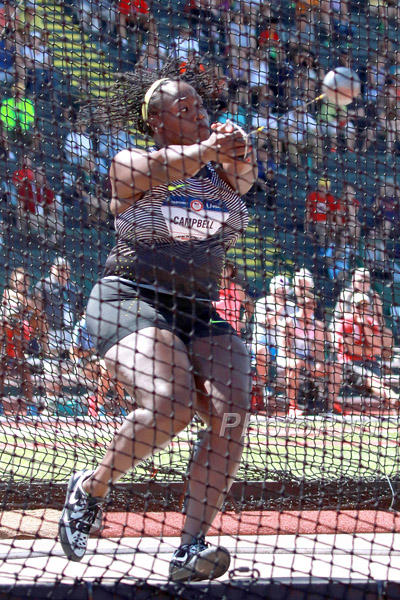 Amber Campbell, photo by PhotoRun.net
Amber Campbell, photo by PhotoRun.net
Isaac Gibson wrote our day six coverage on the hammer time in Hayward. Special thanks to Professor Lori Shontz for the support of her team of track journalists who have helped us all week with daily coverage of the Olympic Trials.
EUGENE, Oregon – One year ago, Vin Lananna approached Lance Deal, a silver medalist at the 1996 Atlanta Olympic Games, and asked him if it was possible to bring the hammer throw inside Hayward Field for the U.S. Olympic Track and Field Trials.
On July 6, not only was hammer throw brought into the stadium, it had an entire day of the trials dedicated to it.
“It was really, really rewarding to help move this sport forward,” said Deal, who is the director of track and field venues for the University of Oregon. “I just couldn’t ask for anything better for the men and women throwing the hammer today. I just am really pleased they got to experience this.”
Women’s meet record broken four times
The athletes were not the only ones to have a unique experience. During the women’s final, a crowd of about 2,900 saw the Olympic trials meet record broken four times.
It all started when Amber Campbell broke her meet record with a throw of 236 feet, 3 inches (72.02 meters) for her first throw in the finals. However, then Gwen Berry threw 236-4 (72.04) on her second attempt and snatched the record from Campbell.
“I went as crazy as I could,” said Berry. “I just want to be an Olympian, and I am.”
Deanna Price, of Southern Illinois, had the lead from her first throw until Campbell’s meet record. She remained focused after Berry’s record-breaking throw and threw 239-9 (73.09) breaking the record yet again, setting a new personal best.
However, Campbell was not going to let her record go easily. On her last attempt, she unleashed a 242-10 (74.03) throw that was not just another meet record, but the best throw by an American this year.
“I knew after the fifth throw I was on the team, so I was just like, ‘have some fun and let it rip.'” Campbell said. “I did not come here to look cute. I want to go for the win and go for the American record.”
Men fail to meet Olympic standard
However, on the men’s side, it is not even clear if there will be an Olympian among the top three finishers.
Entering the meet, none of the male hammer throwers achieved the Olympic standard of 252-7 (77 meters), and to make the Olympic team one must have the standard. There are currently only 23 people with the standard.
“It is nerve-racking, and it is a little annoying that the standard is so high all the time for the hammer throwers,” said Conor McCullough, the third-place finisher. “Funding from national bodies is based on these standards, but when it is so high in our event, we do not get funding.”
Cornell’s Rudy Winkler came very close when he unleashed a personal best of 251-10. It was the best throw by an American this year and only nine inches off the standard.
“I feel like I have more and I can throw further,” said Winkler. “I was really hoping to get the Olympic standard, so I do not have to worry about getting an invitation.”
Since there is not a big enough field of athletes who have the standard, invitations are going to be handed out to athletes deemed worthy to compete. It is not well known how the invitations are going to be handed out, or what criteria is going to be reviewed.
“I am hoping I get it, but it is not something I am worrying about,” said Winkler. “This is not the end for me. I am just starting out.”
Behind Winkler were Kibwe Johnson and McCullough who threw 246-5 and 243-4 respectively.



















